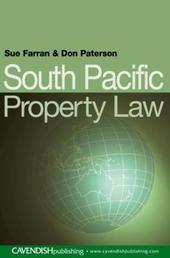
|
South Pacific Property Law
Paperback
Main Details
| Title |
South Pacific Property Law
|
| Authors and Contributors |
By (author) Susan Farran
|
|
By (author) Don Paterson
|
| Series | South Pacific Law |
|---|
| Physical Properties |
| Format:Paperback | | Pages:464 | | Dimensions(mm): Height 234,Width 156 |
|
| ISBN/Barcode |
9781859416600
|
| Classifications | Dewey:346.9504 |
|---|
| Audience | | Tertiary Education (US: College) | | Professional & Vocational | |
|---|
| Illustrations |
black & white illustrations
|
|
Publishing Details |
| Publisher |
Taylor & Francis Ltd
|
| Imprint |
Routledge Cavendish
|
| Publication Date |
6 January 2004 |
| Publication Country |
United Kingdom
|
Description
This book is a treasury of law relating to many different types of property in the South Pacific region. This region is one of cultural diversity, economic development and strong tradition. While land remains of key significance, other forms of property, ranging from custom property to intellectual property, are also important. Encompassing the legal systems of over a dozen independent countries together with cross references to property law derived from the common law and customary law of Australia, New Zealand and North America, as well as the common law of England, the authors bring together a wealth of diverse and scattered sources to present a coherent picture of the law of property as it exists today. The book also offers some thoughts on the challenges and legal difficulties facing the region as its people and economies evolve.
Author Biography
Sue Farran, Senior Lecturer in Law at the University of Dundee and Don Paterson is an Emeritus Professor in the School of Law at University of the South Pacific.
Reviews'In their books South Pacific Property Law, Susan Farran and Don Paterson have done an admirable job of pulling together the law of property in the South Pacific region. The book is divided into eleven chapters, beginning with a general overview of property law, with each subsequent chapter detailing specific property law concepts such as ownership, possession and occupation, alienation and remedies in property law. The book has a number of excellent points, one of which is the inclusion of an extensive list of cases and legislation from the region. I found that the author's use of cases highlighted the complexity of the law in the Pacific, as well as making those aspects of English common law property, which are often the bane of first-year law students, much more interesting. For example, in discussing standards of certainty for conditions subsequent and conditions precedent, the authors drew on the Fijian case Native Land Trust Board v. Maikeli Nagata, which applies the common law rule of condition subsequent to customary land. Another valuable feature of the book is the customary law is included as source of law and considerable attention to traditional processes of resolving claims. In chapter 5, Management of Property, there is discussion of customary law as it relates to restricted use and management of property. Making customary law a central element of the book is not only important for highlighting the unique legal culture in the South Pacific, but also provides a nice example of how to write about customary law without relegating "custom" to the unimportant (see black letter law texts) or the "Exotic" (which can be a tendency in legal anthropology).. I would highly recommend it to anyone who is grappling with issues of legal pluralism or the operation of customary law in post-colonial states, even if one is not particularly interested in property law per se. Despite the lack of detail on certain aspects of property law, the book provides a good overview of the law of property in the South Pacific and I would recommend it to anyone interested in comparative law, legal anthropology or property law in general.' Pacific Affairs: Volume 78, No. 1 - Spring 2005
|